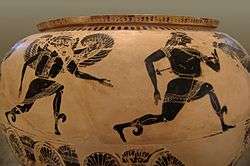Gorgon Painter
| Gorgon Painter | |
|---|---|
|
| |
| Born |
Unknown. Named from the theme of the vase shown. Before 600 BC Probably Athens |
| Died | Around 580 BC |
| Nationality | Greek |
| Known for | Vase painting, pottery manufacture |
| Notable work | He produced small vases in his own workshop. |
| Movement | Black-figure style |
| Wikimedia Commons has media related to Gorgon Painter. |
The Gorgon Painter was one of the first Attic black-figure vase painters. He was active between 600 and 580 BC. The Gorgon Painter is considered as the very productive successor of the Nessos Painter, whose fanciful style he adopted, adapted and organised. His conventional name is based on his name vase, a '’dinos’’ in the Louvre (E 874), depicting Perseus fleeing the gorgons. He was the first representative of the animal frieze style in Athens; painting animal friezes influenced closely by Corinthian precedents. Additionally, he arranged his demonic animals in symmetric patterns. Characteristic of his paintings are lions with box-shaped snouts and manes painted as hatchings or red flames. He rarely painted humans; where he did, they are always accompanied by animals or animal friezes. His name vase is his only piece to depict a complex narrative, but also the first Attic vase to do so at all. Overall, the Gorgon Painter was highly dependent on Corinthian vase painting. His human figures are considered stiff and mannerist. Apart from '’dinoi’’, he painted an early form of '’lekythoi’’, resembling Corinthian '’aryballoi’’, '’olpes’’, plates, '’amphoriskoi’’, '’kothones’’ and '’oinochoai’’. His workshop founded a tradition that can be traced over a long time, especially on '’olpes’’. Imitations of his work are known from Boeotia.
Bibliography
- John Beazley: Attic Black-figure Vase-painters. Oxford 1956, p. 8-10.
- John Boardman: Schwarzfigurige Vasen aus Athen. Ein Handbuch, von Zabern, 4. edn, Mainz 1994.(Kulturgeschichte der Antiken Welt, Vol 1) ISBN 3-8053-0233-9, p. 19.
